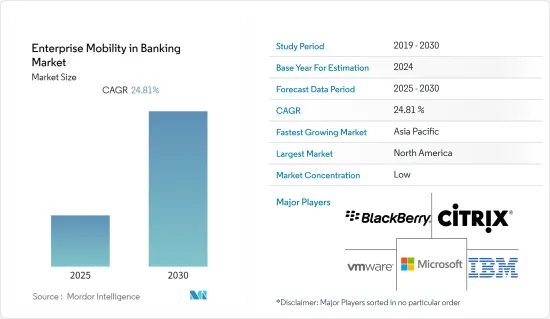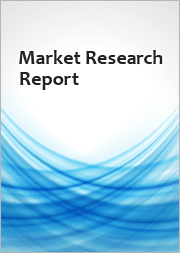
|
시장보고서
상품코드
1628794
은행 업계 엔터프라이즈 모빌리티 - 시장 점유율 분석, 업계 동향 및 통계, 성장 예측(2025-2030년)Enterprise Mobility in Banking - Market Share Analysis, Industry Trends & Statistics, Growth Forecasts (2025 - 2030) |
||||||
은행 업계 엔터프라이즈 모빌리티 시장은 예측 기간 동안 24.81%의 연평균 복합 성장률(CAGR)을 나타낼 것으로 예상됩니다.

주요 하이라이트
- 모바일 기기는 거의 보편화되어 있으며, 기업 전체에서 비슷한 추세를 보이고 있습니다. 따라서 기업이 적절한 관리를 도입하면 기밀 데이터와 디바이스를 보호하면서 모빌리티의 기회를 활용할 수 있을 것으로 기대됩니다. 예를 들어, EMM 조치는 기업의 용도, 컨텐츠 및 디바이스가 완전히 통합되고 안전한 액세스 메커니즘을 포함하여 안전하게 사용할 수 있도록 보장합니다.
- 은행과 동맹국들은 BYOD를 허용하는 방향으로 나아가고 있으며, 금융 거래소의 안전한 데이터와 규제 준수를 위해 EMM이 필요하며, macOS, Windows 10, 견고한 장치 등 다양한 OS와 사물인터넷(IoT)의 확산으로 인해 모바일 하드웨어의 모바일 하드웨어 환경이 확대되면서 기업들은 EMM에 집중할 수 있게 되었습니다.
- 또한 은행 업계는 전체 기기 재고를 관리하고 기기가 온라인인지 오프라인인지 여부를 추적하는 적절한 시스템이 필요합니다. 은행은 주로 영업 사원이 현장에서 사용하는 모든 모바일 기기를 추적하고 직원들이 효과적으로 사용하고 있는지 확인해야 합니다. 관련 없는 동영상 시청, 게임, 앱 설치 등 의도하지 않은 기기 사용은 생산성을 떨어뜨릴 수 있습니다.
- 또한, 코로나 바이러스 전염병은 대부분의 기업들에게 예측할 수 없는 세계 상황을 초래했습니다. 은행 업계는 직원들이 원격으로 업무를 수행할 수 있도록 지원해야 했습니다. 중단 없는 서비스 지속을 촉진하는 디지털 인프라에 대한 요구가 증가함에 따라 업계에서 모빌리티 솔루션에 대한 수요가 증가할 것으로 예상됩니다.
- 그러나 모바일화에 대한 심각한 도전과 진입장벽 중 하나는 높은 비용으로, BYOD 솔루션이라 할지라도 예산은 통합, 개발, 통신 및 기타 여러 가지를 포함해야 합니다. 또한 새로운 모바일 앱과 기술을 기존 인프라에 통합하는 데는 많은 비용과 시간이 소요됩니다.
은행업계의 엔터프라이즈 모빌리티 시장 동향
사이버 공격 증가가 시장 성장 견인
- 데이터 유출은 급격한 비용 상승과 귀중한 고객 정보 손실로 이어집니다. 지난해 X-Force Threat Intelligence Index에 따르면, X-Force가 대응한 공격의 22.4%가 금융 및 보험 업계를 대상으로 한 공격이었고, 그 중 70%가 은행을 대상으로 한 공격이었습니다. 따라서 지난해 X-Force의 산업별 순위에서 금융 및 보험 산업은 2위를 차지했습니다. 사이버 공격자들은 금전적 이익을 얻는 가장 쉬운 방법을 찾기 위해 금융 서비스 산업을 공격하고 있습니다.
- 또한, 2022년 12월에 발표된 시스코의 최신 연례 보안 성과 보고서에 따르면, 조사 대상 조직의 62%가 지난 2년 동안 비즈니스에 영향을 미치는 보안 이벤트를 경험했다고 응답한 것처럼, 사이버 보안 인내력은 빠르게 증가하는 위협에 대비하기 위한 기업의 최우선 과제입니다. 위협으로부터 자신을 보호하기 위한 기업의 최우선 과제가 되고 있습니다.
- 공공 및 민간 금융기관은 IT 시스템을 보호하고 고객의 중요한 데이터를 보호하며 정부 규제를 준수하기 위해 사이버 공격을 방지하는 최신 기술을 도입하는 데 주력하고 있습니다. 또한, 고객의 기대치 상승, 기술력 향상, 규제 요건 강화로 인해 은행들은 보안에 대한 적극적인 접근 방식을 채택하고 있습니다.
- 또한, 모바일 뱅킹, 인터넷 뱅킹과 같은 디지털 채널과 함께 기술 보급이 확대되고 있으며, 고객들은 은행 서비스를 선택하게 되었습니다. 은행이 첨단 인증 및 접근 제어 프로세스를 활용해야 할 필요성이 높아지고 있습니다.
북미가 괄목할 만한 성장세를 기록합니다.
- 북미는 은행 업계 엔터프라이즈 모빌리티 시장에서 큰 비중을 차지할 것으로 예상되며, 은행 간 도입 증가와 주요 벤더의 존재가 이 지역 시장 성장을 가속하는 주요 요인으로 작용할 것으로 보입니다.
- 미국에서는 스마트폰 및 태블릿PC의 보급률이 높아지면서 기업 전반의 BYOD 정책이 추진될 가능성이 높습니다.
- Identity Theft Resource Center(ITRC)에 따르면, 미국에서는 지난해 상반기에만 817건의 데이터 유출 사고가 발생했습니다. 이는 해커가 기업 시스템에 침입하기 위해 공격할 수 있는 가장 취약한 엔드포인트이기 때문입니다. 최종 사용자의 인식이 높아짐에 따라 미국 내 매니지드 모빌리티 서비스에 대한 수요는 예측 기간 동안 증가할 것으로 예상됩니다.
- 또한 북미, 특히 미국에서는 사이버 공격이 급증하고 있습니다. IBM에 따르면 지난해 미국 내 데이터 침해의 평균 비용은 944만 달러로 2021년 905만 달러에 비해 증가했으며, 이 지역의 모바일 기기 급증으로 인해 사이버 공격이 사상 최고치를 기록했다고 합니다.
은행업계의 엔터프라이즈 모빌리티 산업 개요
은행업계의 엔터프라이즈 모빌리티 시장은 세분화되어 있으며, 많은 기존 및 신규 진출기업들이 온프레미스 또는 클라우드를 통해 모빌리티 솔루션을 제공합니다. 대부분 스마트폰 관련 서비스에 집중하고 있습니다.
지난 5월, GEMx Technologies는 호쿠앱스(HokuApps)와의 제휴를 발표하며 코로나19 이후 디지털 지갑으로의 전환을 촉진할 것이라고 밝혔습니다. 이번 제휴를 통해 기업용 웹 솔루션을 구축하여 은행 및 금융 서비스 워크플로우를 디지털화 및 통합하고 고객 경험을 향상시키면서 기업에게 간편한 결제 경험을 제공할 수 있게 됩니다.
기타 혜택
- 엑셀 형식 시장 예측(ME) 시트
- 3개월간의 애널리스트 지원
목차
제1장 서론
- 조사의 전제조건과 시장 정의
- 조사 범위
제2장 조사 방법
제3장 주요 요약
제4장 시장 인사이트
- 시장 개요
- 산업의 매력 - Porter의 Five Forces 분석
- 공급 기업의 교섭력
- 소비자의 교섭력
- 신규 진출업체의 위협
- 경쟁 기업간 경쟁 관계
- 대체품의 위협
- COVID-19산업에 대한 영향 평가
- 시장 성장 촉진요인
- 시장이 해결해야 할 과제
제5장 시장 세분화
- 유형별
- 솔루션
- 디바이스 관리
- 액세스 관리
- 애플리케이션 관리
- 기타 솔루션
- 서비스
- 솔루션
- 지역
- 북미
- 유럽
- 아시아태평양
- 기타
제6장 경쟁 구도
- 기업 개요
- BlackBerry Limited
- VMware Inc.
- Citrix Systems Inc.
- IBM Corporation
- Microsoft Corporation
- Mobile Iron Inc.
- Accenture Plc
- Newgen Software Technologies Limited
- Infosys Limited
- HCL Technologies
제7장 벤더의 시장 점유율 분석
제8장 투자 분석
제9장 시장 장래성
LSH 25.01.22The Enterprise Mobility in Banking Market is expected to register a CAGR of 24.81% during the forecast period.

Key Highlights
- Mobile devices are almost ubiquitous and are displaying similar trends across enterprises. Thus, deploying appropriate controls in companies is expected to benefit them from mobility opportunities while ensuring that sensitive data and devices are safeguarded. For instance, an EMM policy ensures that the enterprise's application, content, and device are fully integrated and safe to use, including secure access mechanisms.
- The banks and allies are pivoting to allow BYOD and require EMM for secure data and regulatory compliance for their financial exchanges. With the proliferation of multiple OS, like macOS, Windows 10, and ruggedized devices, along with the Internet of Things (IoT), the mobile hardware context enlarges, enabling enterprises to focus on EMM.
- Further, the banking industry needs a proper system to manage the overall inventory of devices and track whether the devices are online or offline. Banks primarily need to keep track of all their mobile devices used in the field by the salesforce and ensure that the employees are using them effectively. Any unintended use of the devices, such as watching non-related videos, playing games, or installing any app, can lead to a loss of productivity.
- Additionally, the coronavirus outbreak caused an unpredictable worldwide situation for most businesses. Banks needed to enable their employees to operate remotely in the banking industry immediately. The rising need for digital infrastructure to facilitate the continuation of uninterrupted services is expected to create a demand for mobility solutions in the industry.
- However, one of the critical challenges and barriers to entry for mobilization is the high cost. Even with BYOD solutions, the budget still has to cover integration, development, telecom, and many others. Also, integrating new mobile apps and technologies into the existing infrastructure can be expensive and time-consuming.
Banking Enterprise Mobility Market Trends
Increase in Cyber Attacks to Drive Market Growth
- Data breaches lead to an exponential cost rise and the loss of valuable customer information. According to the X-Force Threat Intelligence Index of last year, 22.4% of attacks that X-Force addressed targeted financial and insurance businesses, out of which 70% of attacks were on banks. Thus, financial and insurance businesses were second in X-Force's industry rankings in the previous year. In pursuit of the most straightforward path possible to financial gain, cyber attackers attack the financial services industry.
- Moreover, according to the latest edition of Cisco's annual Security Outcomes Report launched in December 2022, cybersecurity resilience is a foremost priority for companies as they look to protect against a rapidly growing threat landscape as 62 percent of organizations surveyed stated they had experienced a security event that impacted business in the past two years.
- To secure their IT systems, secure customer vital data, and comply with government regulations, public and private banking institutes are focused on executing the latest technology to prevent cyber attacks. Additionally, with higher customer expectations, rising technological capabilities, and regulatory requirements, banking institutions are driven to adopt a proactive approach to security.
- Further, the growing technological penetration, coupled with digital channels, such as mobile banking and internet banking, are becoming customers' preferred choice for banking services. There is a greater need for banks to leverage advanced authentication and access control processes.
North America to Witness Significant Growth
- North America is expected to hold a significant share of enterprise mobility in the banking market, with the increasing adoption among banks and the presence of major vendors acting as the primary factors driving the market growth in the region.
- The penetration of smartphones and tablets is rising in the United States, which will likely propel the BYOD policy across enterprises.
- According to the Identity Theft Resource Center (ITRC), the number of data compromises in the United States witnessed 817 cases in the first half of the last year. These incidents have created a positive demand for enterprise mobility management in the country, especially for mobile security, as they are the most vulnerable endpoints a hacker can attack to gain entry into an enterprise system. With growing awareness among the end-users, the demand for managed mobility services in the country is expected to increase over the forecast period.
- Moreover, cyber attacks in the North American region, especially in the United States, are rising rapidly. They have reached an all-time high, primarily owing to the rapidly increasing number of mobile devices in the region. According to IBM, the average cost of a data violation in the United States amounted to USD 9.44 million in the last year, up from USD 9.05 million in 2021.
Banking Enterprise Mobility Industry Overview
The market for enterprise mobility for banking is fragmented, with many existing and new players offering mobility solutions through on-premise or cloud. The majority are focused on smartphone-related services.
In May 2022, GEMx Technologies announced its partnership with HokuApps to promote the shift to digital wallets after the COVID-19 pandemic. The partnership would enable digitizing and integrating banking and financial service workflows by creating an enterprise web solution to create easy payment experiences for businesses while improving customer experience.
Additional Benefits:
- The market estimate (ME) sheet in Excel format
- 3 months of analyst support
TABLE OF CONTENTS
1 INTRODUCTION
- 1.1 Study Assumptions and Market Definition
- 1.2 Scope of the Study
2 RESEARCH METHODOLOGY
3 EXECUTIVE SUMMARY
4 MARKET INSIGHT
- 4.1 Market Overview
- 4.2 Industry Attractiveness - Porter's Five Forces Analysis
- 4.2.1 Bargaining Power of Suppliers
- 4.2.2 Bargaining Power of Consumers
- 4.2.3 Threat of New Entrants
- 4.2.4 Intensity of Competitive Rivalry
- 4.2.5 Threat of Substitute Products
- 4.3 Assessment of COVID-19 Impact on the Industry
- 4.4 Market Drivers
- 4.4.1 Growth of Mobile Devices as the Preferred Medium of Accessing Internet, Enterprise Data, and Various Other Information
- 4.4.2 Rising Trend of BYOD
- 4.5 Market Challenges
- 4.5.1 High Cost of Implementation, Coupled with Lack of Acceptability Among Employees
5 MARKET SEGMENTATION
- 5.1 By Type
- 5.1.1 Solutions
- 5.1.1.1 Device Management
- 5.1.1.2 Access Management
- 5.1.1.3 Application Management
- 5.1.1.4 Other Solutions
- 5.1.2 Services
- 5.1.1 Solutions
- 5.2 Geography
- 5.2.1 North America
- 5.2.2 Europe
- 5.2.3 Asia Pacific
- 5.2.4 Rest of the World
6 COMPETITIVE LANDSCAPE
- 6.1 Company Profiles
- 6.1.1 BlackBerry Limited
- 6.1.2 VMware Inc.
- 6.1.3 Citrix Systems Inc.
- 6.1.4 IBM Corporation
- 6.1.5 Microsoft Corporation
- 6.1.6 Mobile Iron Inc.
- 6.1.7 Accenture Plc
- 6.1.8 Newgen Software Technologies Limited
- 6.1.9 Infosys Limited
- 6.1.10 HCL Technologies



















